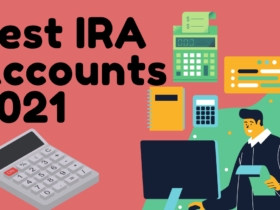IRA is also known as individual retirement account. An IRA is an investment account that provides tax breaks for retirement savings. Even those of the best ways to prepare for some years can open a later without the use of sponsored retirement plan by an employer – to invest money in an IRA as earned income.
However, before you contribute to an IRA. You must type in a way that is right for your situation, and you must learn the rules of the two free withdrawals from discount contributions and penalties.
What Is an IRA?
An Individual Retirement Account (IRA) is a tax facility account that individuals use to save and invest for retirement. The Internal Revenue Service (IRS) also used the term “Individual Retirement Arrangements (IRAs) broadly for personal retirement accounts. Individual retirement annuities and other trusts and custodial accounts with tax benefits that act as personal savings Retirement refer to the establishment of separate money for the plan.
Read Also- Planning for Retirement in 2021
Types of IRAs
An IRA is a type of account that can look and feel like any other account (such as your taxable brokerage account or a bank account). But some tax features make accounts different from other types of retirement accounts. MPs have designed these accounts to promote retirement savings, so there are potential benefits to using the accounts there. There are also restrictions that discourage early evacuation.
There are several types of IRA acount including- Traditionl, Roth, Rollover
#1. Roth IRA
Roth IRAs do have the ability to free development. Instead of taking a deduction for contributions, you contribute after-tax dollars into Roth accounts. When you take distributions in retirement, you are free (you may get all the full assumption) money all IRS requirements. In other words, you’re free to your original contributions and any earnings.
Roth IRAs unique restrictions are not applicable to traditional IRAs, including latency and income limit of five years that may prevent you from contributing. As has been said, you can usually take your contributions to a Roth at any time without penalty. That note is that Roth IRAs makes flexible relatively unexpected needs, but you can get results when you remove earnings from your account.
#2. Rollover IRA
Rollover IRAs are funded by a retirement account that traditional IRAs. For example, you can pre-A rollover can be 401 (a) roll estate IRA. In the past, it might have been those assets is excluded, but is ideal for the current combination of assets.
Nevertheless, there may be good reasons to keep separate IRAs for different money sources. 4 When you are concerned about creditor security, retirement planning rules, and other issues, a “drain IRA” may be appropriate .
#3. Traditional IRA
Traditional IRAs can provide tax-deferred growth; As the account earnings are not taxed each year it will be in a standard bank account. Instead, you can re-invest and take advantage of compounding into account any income.
You can also receive tax benefits as a deduction for the money that you contribute to a traditional IRA, allowing you to add “pre-tax” money to your account.
However, if you do your household is eligible for income and deductions on the basis of workplace benefits, you may be required to contribute later. When you are spending account (retirement, for example, take money out), will make any financial contribution to any never before tax and income tax year in income to distribution agreed.
#4. SEP-IRAs
Simplified Employee Pension IRAs, or SEP IRAs, small business owners can be set up by self-employed individuals. Can only employers contribute to this type of self-employment account.
Annual contribution limits compensated employees for 2021 or less than about $ 57,000) and 25% of $ 58,000 for 2020. There is no income limit for contributions to a SEP-IRA.
#5. SIMPLE IRAs
Just can contribute to this type of account as of September IRAs, employers and self-employed can SIMPLE IRAs set, but with both employers and employees. Employees can contribute up to $ 13,500 in 2020, with 50 in 2021, and is more than qualified, they plan to contribute to hold it permits $ 3,000 up. Account is no income limit to contribute to this type.
Investments in IRAs
Account with an IRA can stay just one type. A “wrapper” is not a significant impact on their choices for the IRA to-find investment features as around another account acquainted with you.
Although some exceptions, it includes investing an IRA mainstream investment almost any kind inside the vehicle, savings accounts, cash in certificates of deposit (CDs), risky like mutual funds or ETFs, and more Huh. The right investment will depend on many factors, including its goals and potential risks with their savings.
Where to Open an IRA
You can open an IRA for banks, credit unions, investment firms and other financial institutions. To determine where you ask a provider about the types of fees and extra charges, and other facilities in the investment property should open your IRA, annual custody.
READ ALSO- Pension Plan- What is Pension Plan
Advantages of IRAs
- You do not need an employer to open an IRA for you: Although there are some types of IRAs that employers can offer to employees, you can set the most common IRA account types (Traditional and Roth) for yourself.
- Contributions provide significant tax advantages: While Roth IRAs to benefit from tax-free return of retirement to traditional IRAs allow you, allow you to contribute to your account with pre-tax dollars.
- You have more flexibility in investment options: You can choose from a wide variety of offers to hold their financial institutions IRA, brokerage accounts, Robo-consultants, and banks. These types of accounts for choosing generally, many different investments so that you provide will be available in a typical workplace 401 (k) plans can invest your money in a very wide variety of assets.
Disadvantages of IRAs
- Usually, you have to manage your IRA yourself, Meaning that you should know how to hold a brokerage firm or other financial institution account, and you must choose your investments to your portfolio. You may have a financial institution that offers open your IRA investment management, but it is expensive, can eat into your savings.
- Where a traditional or Roth IRA must report their contributions to the IRS to contribute yourself to a traditional IRA.
- You cannot withdraw money from a traditional IRA until age 59 1/2 without paying a 10% penalty unless you have a special withdrawal to pay for such large medical expenses that are not included in health insurance.
FAQ-
Ans- 401 (k) among the main difference and IRAs that employers offer 401 (k), but people open IRAs (using brokers or banks). IRAs typically offer more investment; 401 (a) allow higher annual contribution. If the IRA vs. That match based on a 100% return, can offer 401 (k) on your money.
Ans- The IRA is a type of tax-streamlined investment account that can help individuals plan and save for retirement. IRAs allow a wide range of investments, but as with any volatile investment — individuals can lose money in an IRA if their investment is dinged by the highs and lows of the market.
Ans- Any investment is completely safe, but there are five (bank savings accounts, CDs, treasury securities, money market accounts, and fixed annuities) that are considered among the safest investments you can make.







